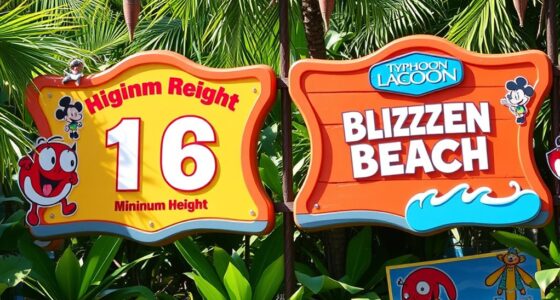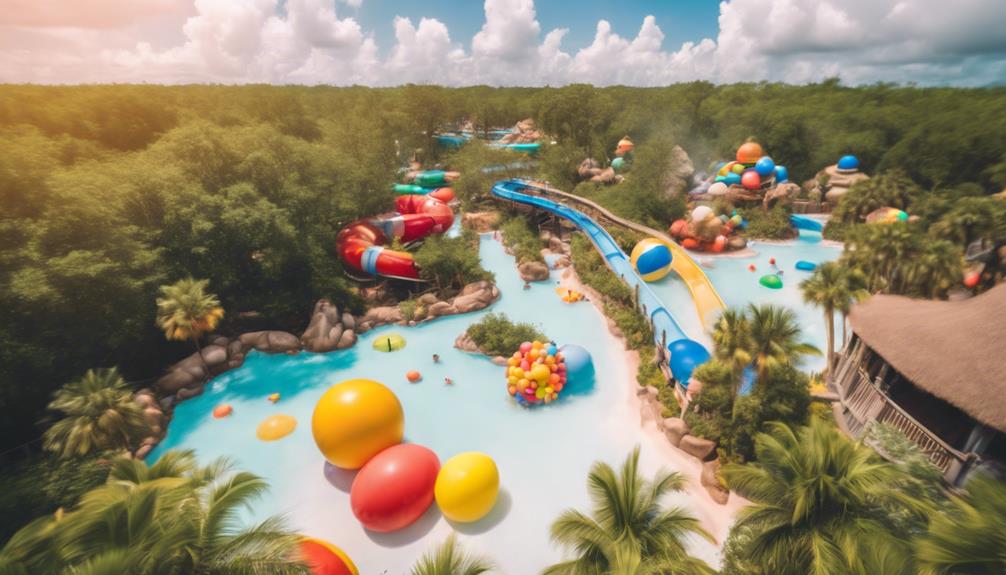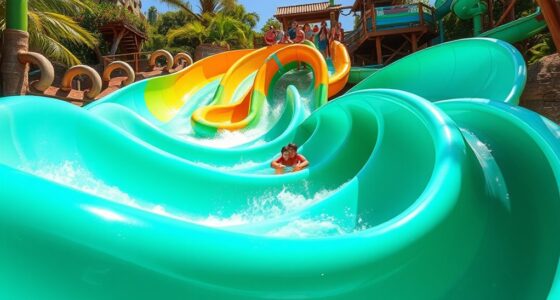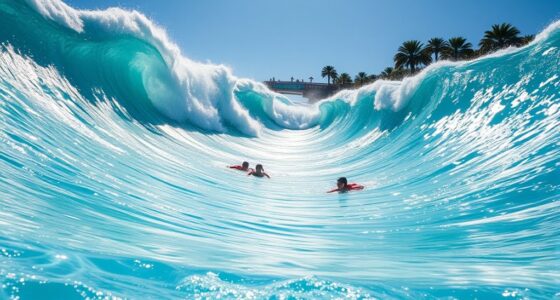If you prefer a laid-back, family-friendly vibe with fewer crowds, Typhoon Lagoon offers relaxing rides, a tropical setting, and straightforward pricing. Volcano Bay is bigger, more vibrant, and packed with high-thrill rides, themed areas, and advanced tech features like virtual lines. While Volcano Bay appeals to thrill-seekers and tech enthusiasts, Typhoon Lagoon suits those seeking calm and easy access. Want to find out which park matches your style? Keep exploring the details below.
Key Takeaways
- Volcano Bay offers a larger, more immersive South Pacific theme with high-thrill rides and advanced virtual line technology, while Typhoon Lagoon has a smaller, relaxed tropical stormwreck atmosphere.
- Volcano Bay features around 30 attractions, including high-thrill rides and immersive storytelling; Typhoon Lagoon has fewer rides focused on family-friendly, casual experiences.
- Typhoon Lagoon emphasizes a whimsical, relaxed environment suitable for families and young children; Volcano Bay targets thrill-seekers and tech enthusiasts with intense rides.
- Ticket prices at Volcano Bay are generally higher with demand-based pricing and line-skipping options, whereas Typhoon Lagoon has lower, straightforward pricing without line privileges.
- Typhoon Lagoon operates seasonally and focuses on thematic storytelling; Volcano Bay operates year-round with a vibrant, vibrant environment centered around its iconic volcano.
Size and Layout Differences
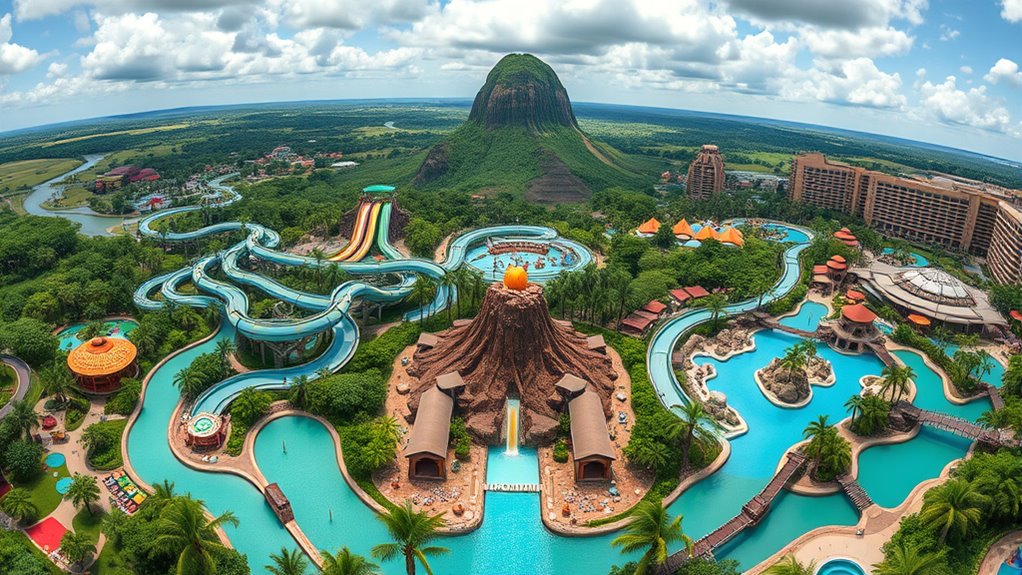
When comparing the size and layout of Typhoon Lagoon and Volcano Bay, you’ll notice that Volcano Bay is larger and more intricately divided into three distinct areas: Wave Village, River Village, and Rainforest Village. Volcano Bay’s expansive layout features a large central volcano, spreading attractions across its themed zones, which creates a more spread-out experience. Typhoon Lagoon’s layout is more centralized around Mount Mayday, with most attractions clustered nearby. Volcano Bay offers extensive seating areas, including over 7,000 beach chairs, providing ample space for relaxation. Both parks include accessible pathways and amenities, but Volcano Bay’s layout, combined with the Tapu Tapu system, enhances ease of navigation and reduces congestion. Additionally, Volcano Bay’s larger size and segmented design create a more immersive and spacious environment.
Ride Selection and Experience Variety
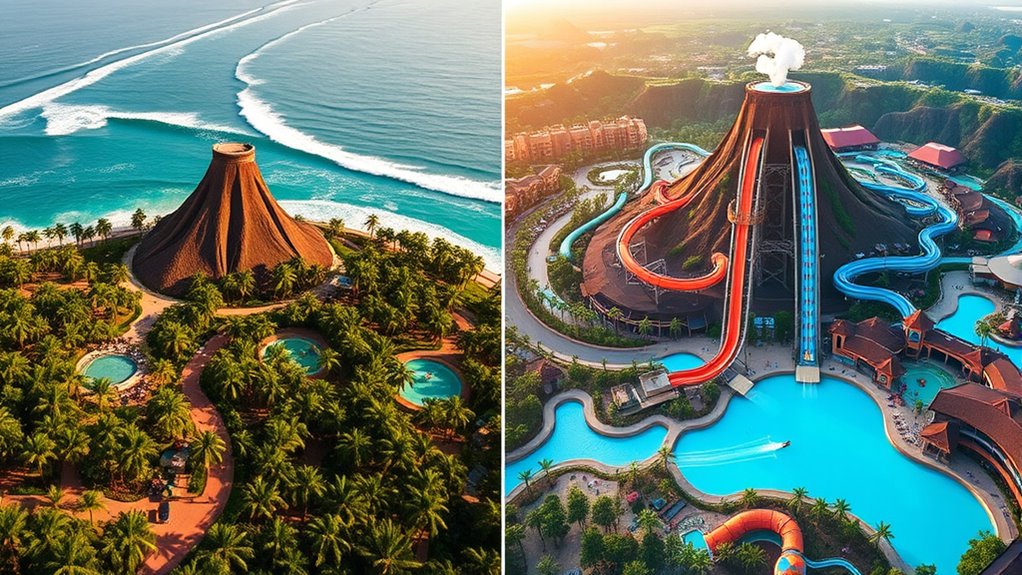
Volcano Bay offers a wider variety of rides and experiences, with approximately 30 unique attractions and 15 rides designed to deliver high-thrill adventures, such as large waterslides and aqua coasters. You’ll find innovative rides like Crush ’n’ Gusher, a water-propelled roller coaster with three slide options, and the vertical Krakatau Slide for adrenaline junkies. In contrast, Typhoon Lagoon has fewer rides, including seven water slides, a small kid slide, a splash zone, lazy river, and wave pool, catering more to families and relaxed experiences. Volcano Bay emphasizes intense, high-thrill rides with vertical drops and magnetic propulsion, while Typhoon Lagoon offers more family-friendly options with fewer height restrictions. This variety lets you choose between thrill-seeking and laid-back fun. Additionally, ride variety is an important factor for many visitors seeking customized water park experiences.
Theming and Atmosphere
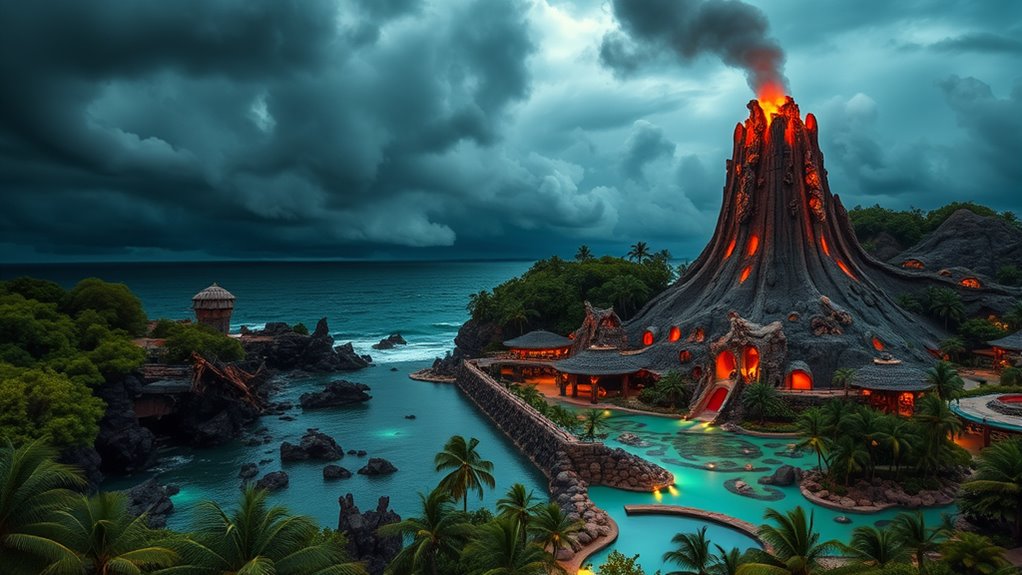
As you explore Typhoon Lagoon and Volcano Bay, you’ll notice how their visual designs and decor immediately set the tone for your experience. Typhoon Lagoon’s whimsical stormwreck theme creates a relaxed, rustic vibe, while Volcano Bay’s vibrant Polynesian details immerse you in a lively island atmosphere. These choices shape the overall mood and make each park’s environment uniquely memorable. Additionally, Volcano Bay features a prominent, towering volcano centerpiece that dominates the landscape, reinforcing its thematic focus and adding to the park’s immersive experience. Theming strategies like these are crucial in creating a cohesive and engaging guest experience.
Visual Design and Decor
Both Typhoon Lagoon and Volcano Bay create immersive visual environments through their distinct theming and decor, but their approaches reflect different atmospheres. Typhoon Lagoon’s stormy, tropical storm theme features expansive beach areas, stormy architecture, and lush foliage that evoke adventure. Volcano Bay, inspired by South Pacific culture, centers around Krakatau, a dramatic volcano, with themed buildings resembling boats and concentrated beaches. Its lighting effects, including glowing sand, enhance the nighttime experience. The parks’ natural landscaping integrates tropical plants and rock formations, but Volcano Bay’s volcano serves as a striking visual focal point. Additionally, the theming and decor elements play a crucial role in shaping visitors’ overall experience and immersion.
Thematic Immersion Level
The level of thematic immersion in these parks hinges on how well their storylines and concepts draw guests into their worlds. Volcano Bay immerses you in a rich storyline inspired by South Pacific island cultures, focusing on the Waturi people and their connection to Krakatau. Universal consulted with islanders to guarantee authenticity, creating themed areas like River Village and Waturi Beach that feel alive and cohesive. Attractions like the Krakatau Aqua Coaster fit seamlessly into this narrative. The park’s landscaping centers around the towering Krakatau volcano, enhancing the story’s depth. Additionally, attention to theming and atmosphere significantly enhances guest engagement and overall experience. Meanwhile, Typhoon Lagoon emphasizes a tropical setting with Mount Mayday and a shrimp boat, Miss Tilly, but lacks the detailed storyline of Volcano Bay. Both parks craft lush environments, but Volcano Bay’s narrative-driven design offers a deeper thematic experience.
Atmosphere and Vibe
You’ll notice that the atmosphere and vibe at each park set a distinct tone for your visit. Typhoon Lagoon has a relaxed, laid-back feel, perfect for unwinding amid tropical storm-themed decor. Its lush landscaping, shipwrecks, and gentle soundscapes create a calm environment ideal for families and those seeking a slower pace. In contrast, Volcano Bay offers a vibrant, energetic vibe with its volcanic landscapes, dynamic lighting, and lively soundtracks. Its themed elements, like water cannons and geysers, enhance the adventurous atmosphere, attracting thrill-seekers. While both parks feature music and sound effects, Volcano Bay’s are more upbeat and intense. Overall, Typhoon Lagoon promotes tranquility, whereas Volcano Bay immerses you in excitement, making each park’s atmosphere uniquely suited to different moods and visitor preferences. Universal Orlando Resort owns Volcano Bay, further contributing to its modern, innovative design and curated experience.
Accessibility and Family-Friendly Features

Volcano Bay offers a range of accessibility features like elevators and a virtual line system that can make visiting easier for guests with mobility challenges. The virtual line system via TapuTapu allows you to reserve ride times, reducing wait stress. However, transferring into rafts for certain rides may be challenging if mobility is limited. In contrast, Typhoon Lagoon, built before the ADA, has more difficulty accommodating guests with mobility issues. When it comes to family-friendly features, both parks shine, but differently. – Volcano Bay has 12 water slides, kids’ splash zones, and a large kiddie area. – Typhoon Lagoon offers attractions suitable for small children without height restrictions. – Typhoon Lagoon’s wave pools and lazy rivers are more accessible. – Volcano Bay’s seating areas are deeper and less accessible. – Typhoon Lagoon provides closer beach seating for families. Since it was constructed earlier, Typhoon Lagoon may lack some of the modern accessibility features found at Volcano Bay.
Pricing Structures and Guest Value
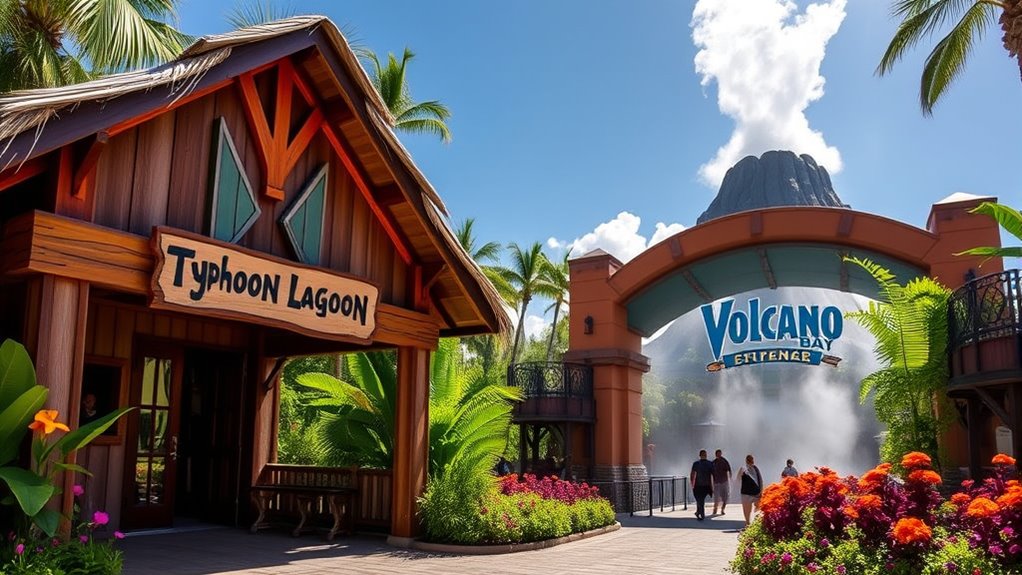
You’ll find that Typhoon Lagoon offers a straightforward, flat-rate ticket price, making it easier to budget, while Volcano Bay’s prices fluctuate based on demand, potentially increasing your costs. Although Volcano Bay’s higher prices reflect its newer rides and attractions, additional fees for amenities like lockers and express passes can add up quickly. Consider whether the extra cost for quicker access and newer experiences at Volcano Bay matches your valued comfort and convenience. Additionally, Volcano Bay’s dynamic pricing can lead to higher ticket costs during peak seasons, which may impact your overall budget. Being aware of potential regulatory compliance challenges can help you plan better for any unforeseen costs or restrictions during your visit.
Ticket Cost Differences
Pricing structures for Typhoon Lagoon and Volcano Bay reflect their different approaches to guest value and flexibility. Typhoon Lagoon offers lower base ticket prices, with adults paying around $74 and children $68, plus discounted blockout date tickets. Volcano Bay’s single-day tickets start at $80 for adults, rising to about $85 on peak days, with children paying roughly $63.75. Volcano Bay’s multi-day and combined park tickets are more complex, often bundled with Universal Orlando parks and starting around $422–$483. Here’s a quick overview:
- Typhoon Lagoon: straightforward, static pricing, few multi-day options
- Volcano Bay: dynamic pricing, flexible multi-park packages
- Discount options: Typhoon Lagoon offers more discounts, like annual passes
- Volcano Bay: limited, often demand-based discounts
- Pricing complexity: Volcano Bay’s varies by date and ticket type
- Additionally, the pricing strategies used by each park influence overall guest experience and perceived value.
Value of Ride Access
Have you ever wondered how ride access impacts the overall value of your water park experience? Volcano Bay offers a clear advantage with its Virtual Line system, allowing you to explore the park while waiting for rides. This reduces downtime and makes your visit more enjoyable. Additionally, Volcano Bay provides elevators and transfer assistance for guests with mobility challenges, enhancing accessibility. If you’re willing to pay extra, the Express Pass lets you skip lines, saving even more time. In contrast, Typhoon Lagoon doesn’t offer line-skipping options, which can lead to longer waits. While Typhoon Lagoon emphasizes a relaxed, tropical vibe, Volcano Bay’s technological innovations and ride variety give it a distinct edge in guest convenience and ride access value. Moreover, Hyundai Tuning options like suspension upgrades and modern engine remapping demonstrate how technological enhancements can significantly improve overall performance and user experience.
Guest Feedback and Popularity

Guest feedback reveals notable differences in the popularity of Typhoon Lagoon and Volcano Bay. You’ll find that Volcano Bay generally receives lower ratings, especially on platforms like Yelp, despite offering a unique, immersive Hawaiian theme. Visitors praise Volcano Bay for its thrilling rides, but note that its layout feels more spread out and less walkable. Typhoon Lagoon is favored for its accessibility, fewer queues, and family-friendly atmosphere, making it more appealing to parents with young children.
- Volcano Bay’s immersive theming vs. Typhoon Lagoon’s tropical vibe
- Higher thrill ride variety at Volcano Bay
- Typhoon Lagoon’s better walkability and fewer queues
- Cost-effective options at Typhoon Lagoon
- Tech features like TapuTapu at Volcano Bay, with occasional issues
Overall Suitability for Different Visitors

When choosing between Typhoon Lagoon and Volcano Bay, your ideal waterpark depends on what kind of experience you’re seeking. If you prefer immersive storytelling and a laid-back vibe, Typhoon Lagoon’s Disney charm and family-friendly attractions are perfect. It’s better suited for young children and those wanting a classic, whimsical environment. Conversely, if you’re an adventure seeker or thrill enthusiast, Volcano Bay’s modern tech, high-speed slides, and adrenaline-pumping rides will appeal. It caters more to teens and adults looking for excitement. Volcano Bay’s year-round operation offers consistent access, while Typhoon Lagoon’s seasonal schedule might suit visitors planning a specific trip window. Overall, Typhoon Lagoon suits families and casual visitors, while Volcano Bay attracts thrill-seekers and tech-savvy guests. Additionally, Universal Orlando Resort’s extensive offerings ensure a variety of experiences beyond the water parks, making both parks excellent choices depending on your preferences.
Frequently Asked Questions
Which Park Has Shorter Wait Times During Peak Seasons?
You’ll find shorter wait times at Typhoon Lagoon during peak seasons. Most attractions usually wait around 10 to 30 minutes, and some rides even have wait times as low as 5 minutes. Volcano Bay tends to have longer waits, especially for popular rides like the water coaster, which can exceed two hours. With better crowd management and a more walkable layout, Typhoon Lagoon helps you enjoy more rides with less waiting.
Are There Any Exclusive Rides Unique to Each Park?
You’ll find exclusive rides that make each park stand out like stars in a night sky. At Typhoon Lagoon, you get Miss Adventure Falls and Mayday Falls, perfect for families and thrill-seekers alike. Volcano Bay offers Krakatau Aqua Coaster and Ko’okiri Body Plunge, designed for adrenaline lovers craving high-speed drops and daring twists. These unique attractions guarantee each park delivers a one-of-a-kind experience, tailored to different adventure styles.
How Do Parking and Transportation Options Compare?
You’ll find that parking at Volcano Bay costs $20, and it’s free at Typhoon Lagoon, which can save you money. If you stay at a Universal hotel, walking to Volcano Bay is easy and free, but you might need an Uber costing around $40 to reach Typhoon Lagoon. Public transport is limited, so your best options are personal vehicles or ride-sharing, depending on your plans and location.
Does One Park Offer Better Food and Beverage Choices?
Imagine stepping into a vibrant marketplace—Volcano Bay offers a feast for your senses with diverse, creative dishes and themed drinks, making it a culinary adventure. Typhoon Lagoon serves straightforward, familiar fare, like a reliable picnic. If you crave variety, bold flavors, and a themed atmosphere, Volcano Bay wins. For simple, clear options with easy dietary info, Typhoon Lagoon keeps it easy. Your choice depends on your taste for culinary excitement versus comfort.
Which Park Provides More Shaded or Relaxing Lounge Areas?
You’ll find more shaded and relaxing lounge areas at Typhoon Lagoon, with extensive scattered chairs, private Beachcomber Shacks, and umbrella rentals. Volcano Bay offers premium cabanas, communal shaded zones, and reserved seating, but these are limited and often require reservations. If you prefer casual, plentiful shade, Typhoon Lagoon suits you better. For private, upscale relaxation, Volcano Bay’s cabanas are ideal, though they come at a higher price.
Conclusion
Ultimately, whether you find yourself drawn to Typhoon Lagoon’s nostalgic charm or Volcano Bay’s modern thrill, both parks surprise you in ways you didn’t expect. As you plan your perfect water day, remember that sometimes, the best adventures happen when you’re open to the unexpected. So, choose your splash, and let the waves of coincidence guide you to a memorable escape—because the right park might just be waiting where you least anticipate.


